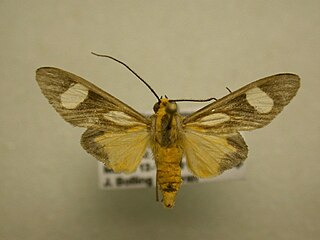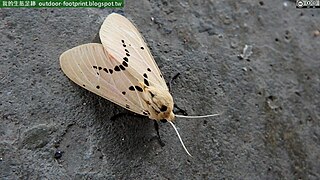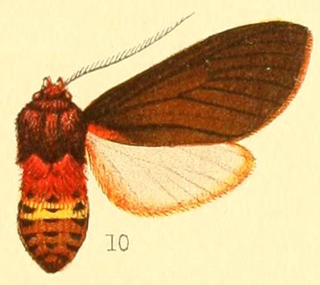Sir George Francis Hampson, 10th Baronet was an English entomologist.

Glaucostola is a genus of moths in the family Erebidae. The genus was erected by George Hampson in 1901.

Paranerita is a genus of moths in the family Erebidae erected by George Hampson in 1901.

Spilarctia is a genus of moths in the family Erebidae. The genus was erected by Arthur Gardiner Butler in 1875.
Teracotona is a genus of moths in the family Erebidae from the Afrotropics. The genus was erected by Arthur Gardiner Butler in 1878.
Hypercalymnia is a genus of moths of the family Noctuidae. The genus was erected by George Hampson in 1909.

Tytroca metaxantha is a moth of the family Erebidae first described by George Hampson in 1902. It is found in South Africa and Zimbabwe.
Amerila leucoptera is a species of moth of the subfamily Arctiinae. It was described by George Hampson in 1901. It is found in Benin, Cameroon, the Democratic Republic of the Congo, Ghana, Ivory Coast, Nigeria, Senegal, Sierra Leone, Tanzania, Uganda and Zambia.
Amerila luteibarba is a species of moth of the subfamily Arctiinae. It was described by George Hampson in 1901. It is found in Angola, Benin, Cameroon, the Democratic Republic of the Congo, Gabon, Ghana, Ivory Coast, Kenya, Liberia, Nigeria, Rwanda, Sierra Leone, Tanzania, Togo and Uganda.

Epimolis incarnata is a moth of the family Erebidae. It was described by George Hampson in 1901. It is found in French Guiana, Brazil, Ecuador and Peru.
Halysidota eudolobata is a moth of the family Erebidae. It was described by George Hampson in 1901. It is found in the Amazon region.

Mazaeras soteria is a moth of the family Erebidae. It was described by Herbert Druce in 1900. It is found in Argentina.
Spilarctia rhodochroa is a moth in the family Erebidae. It was described by George Hampson in 1916. It is found on Java in Indonesia.
Spilarctia hypogopa is a moth in the family Erebidae. It was described by George Hampson in 1907. It is found on Peninsular Malaysia, Sumatra and Borneo. The habitat consists of lowland forests and secondary vegetation.
Spilarctia phaea is a moth in the family Erebidae. It was described by George Hampson in 1901. It is found on Bali in Indonesia.
Spilarctia albicornis is a moth in the family Erebidae. It was described by George Hampson in 1900. It is found in Sri Lanka.
Spilarctia bifascia is a moth in the family Erebidae. It was described by George Hampson in 1891. It is found in the Nilgiris District of India.
Spilarctia castanea is a moth in the family Erebidae. It was described by George Hampson in 1893. It is found in Sri Lanka.
Spilarctia coccinea is a moth in the family Erebidae. It was described by George Hampson in 1907. It is found in the Philippines.
Spilarctia longiramia is a moth in the family Erebidae. It was described by George Hampson in 1901. It is found on Java and Sumatra.





